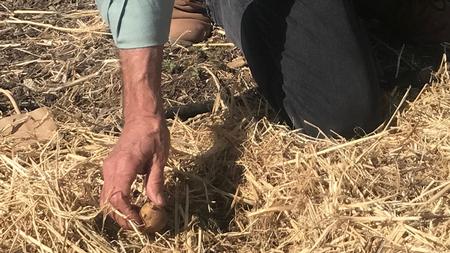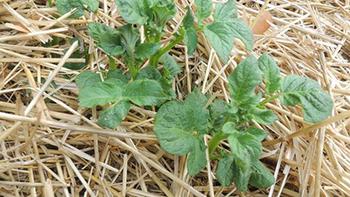News from the Edible Demo Garden
May 2022: No Digging Needed to Grow Potatoes

Seed potatoes are nestled into the straw at planting time. Photo: Marty Nelson
Choosing which potatoes to plant
Whether planting in soil or straw, it’s important to start with seed potatoes that are certified free of pests and diseases. Among the number of factors to consider when choosing which potato varieties to plant are time to maturity, garden size, and determinate versus indeterminate growth type. Determinate varieties mature earlier, require less space, and generally produce smaller tubers. Indeterminate varieties are slower growing, but the yield is higher and the potatoes larger. The four varieties selected for this year’s potato patch are all in the early maturing determinate category:
- Russet Norkotah – brown skinned and oblong, a good potato for baking
 Leaves appearing above the straw indicate that tubers are beginning to form below. Photo: gardeningknowhow.com
Leaves appearing above the straw indicate that tubers are beginning to form below. Photo: gardeningknowhow.com - Yukon Gold – gold skin and flesh, very popular for multiple uses
- Dark Red Norland – red skin and white flesh, tasty boiled and in salads
- Huckleberry Gold – purple skin and white flesh, a new low glycemic variety
The straw planting method
- Prepare the planting bed – Although the potatoes will be growing in straw, the soil underneath needs to be weed free and drain well. Adding compost can help with this. In the Edible Garden, the prepared soil was covered with a layer of straw and drip lines were laid on top.
- Plant the seed potatoes – Seed potatoes are planted whole, if small, or cut in pieces if larger. Each piece should have at least one eye, which is where the sprout will develop. If pieces are cut, it’s good to allow them to age a few days before planting to reduce the chance of decay. Space the seed potatoes 6-12 inches apart. In the Edible Garden the potatoes were nestled into the straw along the drip lines and then covered with more straw
- Keep the straw moist but not wet – The roots growing in the straw can dry out quickly if the moisture content in not maintained but too much moisture can cause rotting. When green leaves appear, add more layers of straw around them to keep the roots covered. Potato tubers exposed to sunlight will turn green and be inedible.
- Harvest after the vines have yellowed and begun to die – It’s hard not to peek, but potatoes need undisturbed time to mature. The appearance of blossoms indicates that growth is also occurring underneath the straw layers. Some gardeners pinch off the flowers to favor tuber growth. It’s at harvest time that the straw bed method can be fully appreciated. There’s no need to go digging into the soil to find potatoes, accidently damaging them in the process. The potatoes come out cleanly from the straw with little effort. Then, it’s “bon appetit”!
Find more tips for growing potatoes on our Edible Grow Sheet on potatoes.

